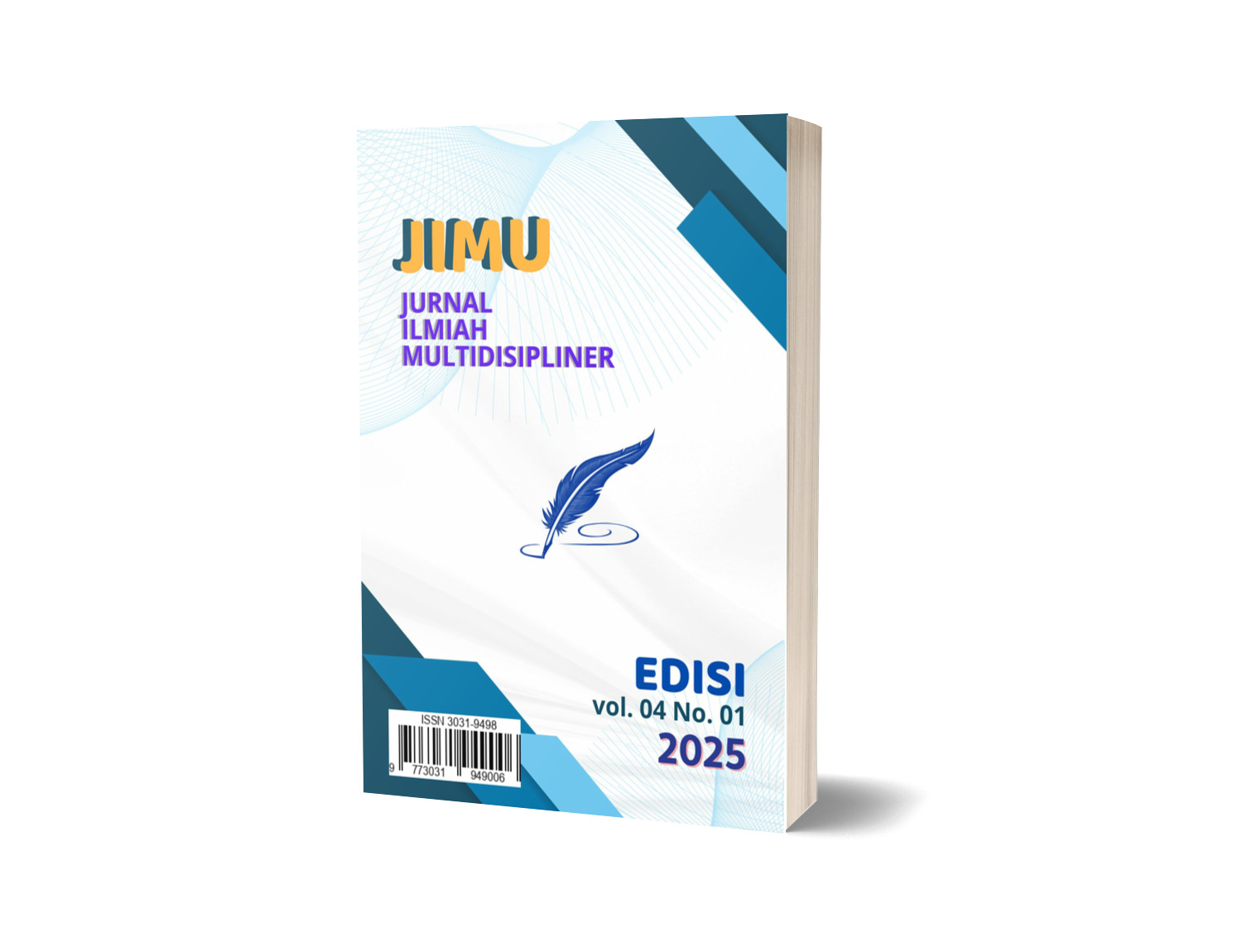Potensi Ekstrak Daun Kelor (Moringa Oleifera) sebagai Agen Antibakteri terhadap Bakteri Patogen Umum
Kata Kunci:
Moringa Oleifera, Daun Kelor, Antibakteri, Kuersetin, Resistensi Antibiotik, Bakteri PatogenAbstrak
Resistensi antibiotik telah menjadi ancaman global yang mendesak bagi kesehatan masyarakat, mendorong pencarian alternatif antimikroba dari sumber alami. Daun kelor (Moringa oleifera) telah lama dikenal sebagai tanaman dengan berbagai khasiat medis, termasuk aktivitas antibakteri. Artikel ini mengkaji potensi ekstrak daun kelor sebagai agen antibakteri terhadap bakteri patogen umum seperti Staphylococcus aureus, Escherichia coli, Pseudomonas aeruginosa, dan Klebsiella pneumoniae. Tinjauan literatur menunjukkan bahwa daun kelor mengandung senyawa bioaktif utama berupa flavonoid (terutama kuersetin), tanin, saponin, dan alkaloid yang memiliki mekanisme antibakteri melalui kerusakan membran sel bakteri, penghambatan sintesis protein, dan gangguan sistem komunikasi sel bakteri. Metode ekstraksi yang umum digunakan meliputi maserasi dan ekstraksi dengan berbagai pelarut seperti etanol, metanol, dan air. Hasil penelitian menunjukkan bahwa ekstrak daun kelor memiliki zona hambat yang signifikan terhadap bakteri Gram positif maupun Gram negatif, dengan konsentrasi hambat minimum (KHM) yang bervariasi tergantung jenis bakteri dan metode ekstraksi. Kuersetin sebagai komponen dominan menunjukkan aktivitas antibakteri melalui interaksi molekular dengan protein bakteri. Kesimpulannya, ekstrak daun kelor menunjukkan potensi besar sebagai alternatif antibakteri alami yang dapat dikembangkan untuk mengatasi masalah resistensi antibiotik, meskipun penelitian lebih lanjut diperlukan untuk aplikasi klinis.
Unduhan
Referensi
Apenteng-Takyiako, S., Takyi, C.A.A., Chama, M.A., Osei, M.M., Donkor, E.S., & Futagbi, G. (2025). In vitro antibacterial activity of Moringa oleifera leaf and seed extracts against antibiotic-resistant bacteria and clinical isolates. BMC Complementary Medicine and Therapies, 25(1), 257. https://doi.org/10.1186/s12906-025-05006-6
Batool, S., Khan, S., & Basra, S.M.A. (2020). Foliar application of Moringa leaf extract improves the growth of Moringa seedlings in winter. South African Journal of Botany, 129, 347-353. https://doi.org/10.1016/j.sajb.2019.06.030
Chen, X., Zhang, Y., Liu, W., Wang, H., & Li, M. (2025). Isolation and characterization of a novel antibacterial protein from Moringa oleifera seeds. Journal of Food Processing and Preservation, 2025, 2934260. https://doi.org/10.1155/jfpp/2934260
Delelegn, A., Sahile, S., & Husen, A. (2020). Phytochemical, antimicrobial, and antioxidant activities of Moringa oleifera Lam. leaves in Eastern Ethiopia. Journal of Chemistry, 2020, 1-9. https://doi.org/10.1155/2020/2934127
Enerijiofi, K.E., Nweze, N.O., & Oguoma, O.I. (2021). GC-MS analysis and antibacterial activities of Moringa oleifera leaf extracts on selected clinical bacterial isolates. Bulletin of the National Research Centre, 45(1), 181. https://doi.org/10.1186/s42269-021-00640-9
Fahey, J.W. (2005). Moringa oleifera: A review of the medical evidence for its nutritional, therapeutic, and prophylactic properties. Trees for Life Journal, 1, 5. https://doi.org/10.1186/1754-2308-1-5
Indonesia.go.id. (2024). Strategi nasional lawan ancaman resistensi antimikroba. Diakses dari https://indonesia.go.id/kategori/editorial/8537/strategi-nasional-lawan-ancaman-resistensi-antimikroba
Kemenkes RI. (2024). Waspada bakteri kebal antibiotik. Diakses dari https://kemkes.go.id/id/waspada-bakteri-kebal-antibiotik
Leone, A., Spada, A., Battezzati, A., Schiraldi, A., Aristil, J., & Bertoli, S. (2022). Chemical analysis and antimicrobial activity of Moringa oleifera Lam. leaves and seeds. Molecules, 27(24), 8920. https://doi.org/10.3390/molecules27248920
Oyebamiji, A.K., Akintelu, S.A., Otun, K.O., Salawu, K.M., & Folorunso, A.S. (2021). Phytochemical and antibacterial investigation of Moringa oleifera seed: experimental and computational approaches. Ecletica Quimica, 46(2), 17-25. https://doi.org/10.26850/1678-4618eqj.v46.2.2021.p17-25
Rasheed, H., Gul, M., Saqib, Z., Ali Shah, Z., Ali, H., Xu, T., Khan, S., Zhang, L., Zhao, M., Guo, M., Abbas, G., Ahmad, M., Hussain, I., & Wang, Y. (2024). Antibacterial, antioxidant, cytotoxicity, and phytochemical screening of Moringa oleifera leaves. Scientific Reports, 14(1), 29388. https://doi.org/10.1038/s41598-024-80700-y
Royani, I., Prasetya, A.D., & Widowati, E. (2023). Analysis of the antibacterial activity and the total phenolic and flavonoid contents of the Moringa oleifera leaf extract as an antimicrobial agent against Pseudomonas aeruginosa. Scientifica, 2023, 5782063. https://doi.org/10.1155/2023/5782063
Saleem, A., Saleem, M., & Akhtar, M.F. (2020). Antioxidant, anti-inflammatory and antiarthritic potential of Moringa oleifera Lam: An ethnomedicinal plant of Moringaceae family. South African Journal of Botany, 128, 246-256. https://doi.org/10.1016/j.sajb.2019.11.023
Selmi, S., Rtibi, K., Grami, D., Sebai, H., & Marzouki, L. (2025). Antibacterial properties of Moringa oleifera, Cynara scolymus and Allium fistulosum leaf extracts: molecular docking insights into quercetin's mechanism of action. Journal of the Science of Food and Agriculture, 105(5), 2847-2858. https://doi.org/10.1002/jsfa.14235
Sharma, P., Wichaphon, J., & Klangpetch, W. (2020). Antimicrobial and antioxidant activities of defatted Moringa oleifera seed meal extract obtained by ultrasound-assisted extraction and application as a natural antimicrobial coating for raw chicken sausages. International Journal of Food Microbiology, 332, 108770. https://doi.org/10.1016/j.ijfoodmicro.2020.108770
Tuldjanah, M., Adriansyah, P., & Heldayanti, H. (2024). Pemanfaatan kulit buah kelor sebagai antibakteri Desa Sejahtera Kecamatan Palolo, Kabupaten Sigi, Sulawesi Tengah. Jurnal Pengabdian Kepada Masyarakat Nusantara, 5(1), 1247-1252. https://doi.org/10.55338/jpkmn.v5i1.2678
Ullah, A., Mariutti, R.B., Masood, R., Caruso, I.P., Costa, G.H.G., Freitas, C.M., Santo, C.R., Zanphorlin, L.M., Mutton, M.J.R., Murakami, M.T., & Arni, R.K. (2020). Crystal structure of mature 2S albumin from Moringa oleifera seeds. Biochemical and Biophysical Research Communications, 468(1-2), 365-371. https://doi.org/10.1016/j.bbrc.2015.10.087
UNAIR. (2025). Ancaman resistensi antibiotik di Indonesia yang perlu diwaspadai. Diakses dari https://unair.ac.id/ancaman-resistensi-antibiotik-di-indonesia-yang-perlu-diwaspadai/
Vergara-Jimenez, M., Almatrafi, M.M., & Fernandez, M.L. (2023). Effects of flavonoids and phenols from Moringa oleifera leaf extracts on biofilm processes in Xanthomonas campestris pv. campestris. Antibiotics, 12(4), 689. https://doi.org/10.3390/antibiotics12040689
Virk, A.K., Kumari, C., Tripathi, A., Kakade, A., Li, X., & Kulshrestha, S. (2020). The antimicrobial properties of Moringa oleifera Lam. for water treatment: a systematic review. SN Applied Sciences, 2, 323. https://doi.org/10.1007/s42452-020-2142-4
Wijayaningrum, W.C. (2025). Identifikasi senyawa flavonoid golongan quersetin, penetapan kadar klorofil, dan pengujian aktivitas antibakteri ekstrak daun kelor (Moringa oleifera L.) terhadap Staphylococcus aureus. Undergraduate thesis, Fakultas Sains dan Matematika, Universitas Diponegoro.
Wulandari, D., Putri, A.S., & Rahmawati, D. (2020). Perbandingan aktivitas ekstrak daun kelor dan teh hijau serta kombinasi sebagai antibakteri penyebab jerawat. Jurnal Fitofarmaka Indonesia, 7(1), 13-19. https://doi.org/10.33096/jffi.v7i1.535
Xie, Y., Yang, W., Tang, F., Chen, X., & Ren, L. (2020). Antibacterial activities of flavonoids: structure-activity relationship and mechanism. Current Medicinal Chemistry, 22(1), 132-149. https://doi.org/10.2174/0929867321666140916113443
Yustisi, A.J., Rantisari, A.M.D., & Sadli, A. (2022). Uji aktivitas antibakteri fraksi polar dan non polar daun kelor tangkai merah (Moringa oleifera L.) terhadap Propionibacterium acnes. INHEALTH: Indonesian Health Journal, 1(1), 11-21. https://doi.org/10.56314/inhealth.v1i1.18









